Hotpoint F 53 C.1 IX/HA, F 532 C.1 IX/HA Manual

Istruzioni per l’uso
FORNO
Sommario
IT
|
|
|
|
|
|
Installazione, 2-3 |
IT |
|
GB |
|
FR |
|
|
|
|
|
Posizionamento |
|||
|
|
|
|
|
|
Collegamento elettrico |
|
|
|
|
|
|
|
Italiano, 1 |
English,12 |
Français, 22 |
Targhetta caratteristiche |
|||
ES |
|
PT |
|
NL |
|
|
|
|
|
|
|
Espanol, 32 |
Portuges, 42 |
Nederlands, 52 |
|||
|
|
|
|
|
|
DE |
|
|
|
|
|
|
|
|
|
|
|
Deutsch, 62 |
|
|
|
|
|
Descrizione dell’apparecchio, 4
Vista d’insieme Pannello di controllo
Avvio e utilizzo, 5
Avviare il forno
Programmi, 6-7
Programmi di cottura
Consigli pratici di cottura
Tabella cottura
F 532 C.1/HA
F 532 C.1 IX/HA F 53 C.1/HA
F 53 C.1 IX/HA
Il programmmatore di cottura elettronico, 8
Precauzioni e consigli, 9
Sicurezza generale Smaltimento
Risparmiare e rispettare l’ambiente
Manutenzione e cura, 10
Escludere la corrente elettrica Pulire l’apparecchio
Pulire la porta Sostituire la lampadina
Montaggio del Kit Guide Scorrevoli
Assistenza, 11
Assistenza attiva 7 giorni su 7 Estensione di garanzia Airbag
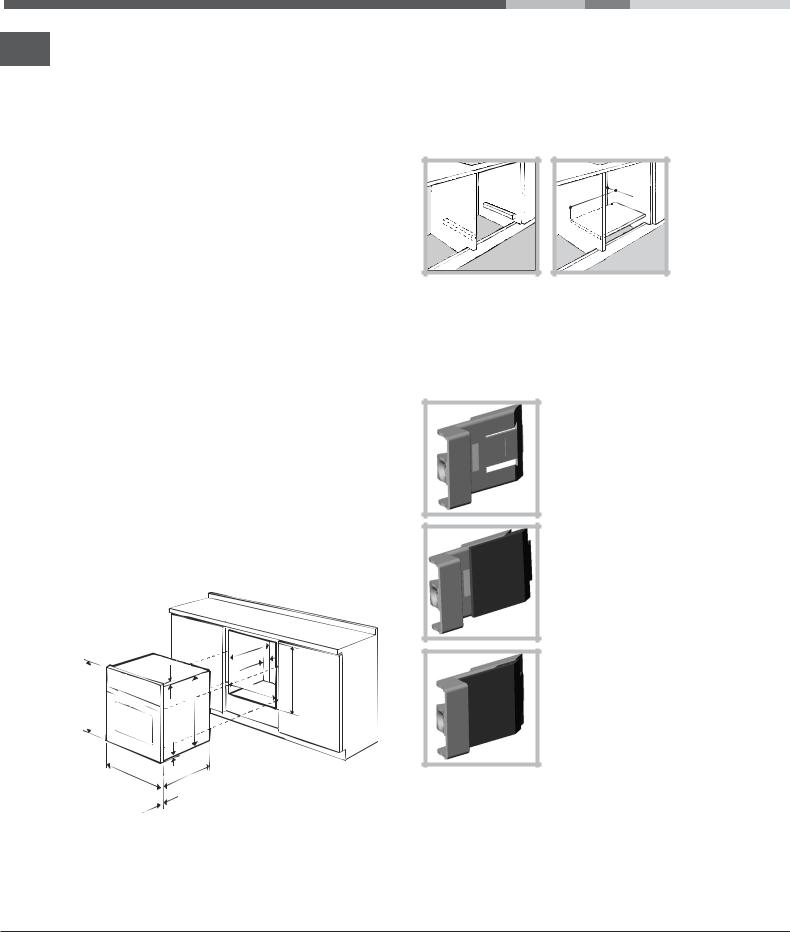
Installazione
È importante conservare questo libretto per poterlo IT consultare in ogni momento. In caso di vendita, di
cessione o di trasloco, assicurarsi che resti insieme all’apparecchio per informare il nuovo proprietario sul funzionamento e sui relativi avvertimenti.
Leggere attentamente le istruzioni: ci sono importanti informazioni sull’installazione, sull’uso e sulla sicurezza.
Posizionamento
Gli imballaggi non sono giocattoli per bambini e vanno eliminati secondo le norme per la raccolta differenziata (vedi Precauzioni e consigli).
L’installazione va effettuata secondo queste istruzioni e da personale professionalmente qualificato. Una errata installazione può causare danni a persone, animali o cose.
Incasso
Per garantire un buon funzionamento dell’apparecchio è necessario che il mobile abbia le caratteristiche adatte:
•i pannelli adiacenti il forno devono essere di materiale resistente al calore;
•nel caso di mobili in legno impiallacciato, le colle devono essere resistenti alla temperatura di 100°C;
•per l’incasso del forno, sia nel caso di inserimento sottotavolo (vedi figura) che a colonna, il mobile deve avere le seguenti dimensioni:
|
23 mm. |
595 mm. |
567 mm. |
|
5 mm. |
595 |
|
m |
|
mm. |
. |
|
m |
|
|
|
545 |
|
. |
|
|
m |
|
|
m |
|
24 |
|
|
|
|
|
|
. |
|
|
|
in |
|
|
|
.m |
|
|
|
m |
|
|
|
|
m |
|
|
|
547 |
|
|
|
|
|
|
|
. |
|
45 |
mm |
|
||
|
|
|
|
|
|
558 |
mm. |
||
|
|
|
||
593 mm.
Una volta incassato l’apparecchio non debbono essere possibili contatti con le parti elettriche. Le dichiarazioni di consumo indicate in targhetta
caratteristiche sono state misurate con questo tipo di installazione.
Aerazione
Per garantire una buona aerazione è necessario eliminare la parete posteriore del vano. È preferibile installare il forno in modo che appoggi su due listelli in legno oppure su un piano continuo che abbia un’apertura di almeno 45 x 560 mm (vedi figure).
. |
45 |
mm |
|
m |
|
. |
|
m |
|
|
|
560 |
|
|
|
Centraggio e fissaggio
Regolare i 4 tacchetti posti lateralmente al forno,
in corrispondenza dei 4 fori sulla cornice perimetrale, in base allo spessore della fiancata del mobile:
spessore di 20 mm: rimuovere la parte mobile del tacchetto (vedi figura);
spessore di 18 mm: utilizzare la prima scanalatura, come già predisposto dal fabbricante
(vedi figura);
spessore di 16 mm: utilizzare la seconda scanalatura (vedi figura).
Per fissare l’apparecchio al mobile: aprire la porta del forno e avvitare 4 viti a legno nei 4 fori posti sulla cornice perimetrale.
Tutte le parti che assicurano la protezione debbono essere fissate in modo tale da non poter essere tolte senza l’aiuto di qualche utensile.
2
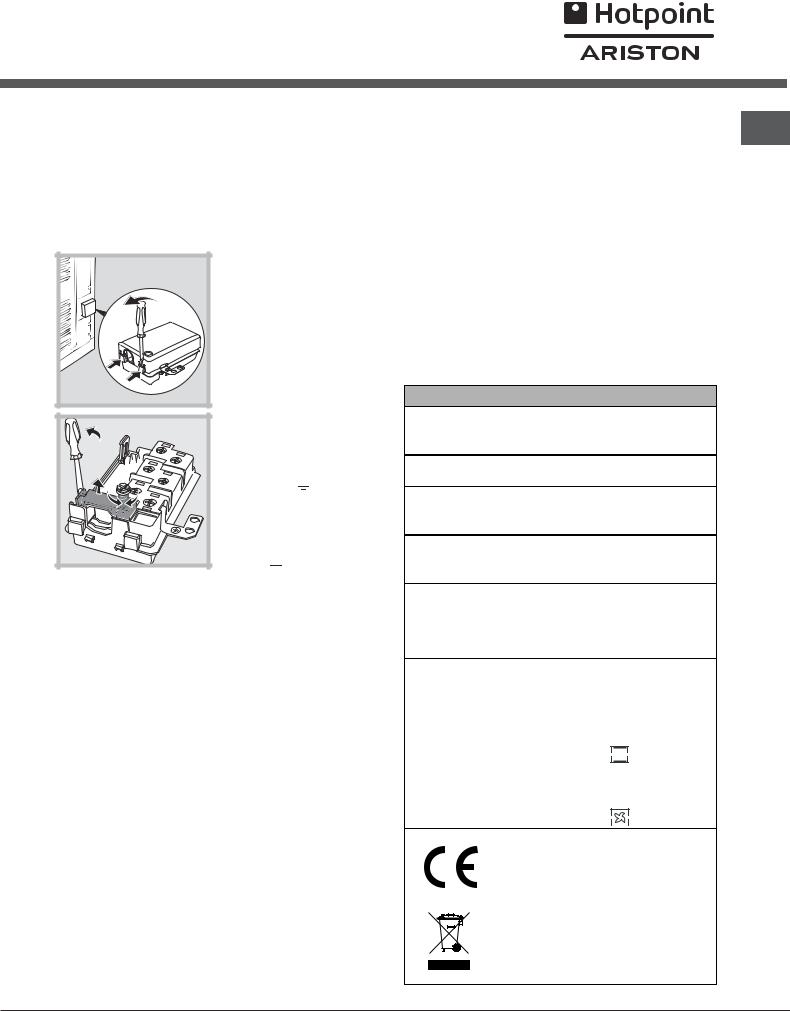
Collegamento elettrico
I forni dotati di cavo di alimentazione tripolare sono predisposti per il funzionamento con corrente alternata, con tensione e frequenza indicate nella targhetta caratteristiche (vedi sotto).
Montaggio del cavo di alimentazione
1. Aprire la morsettiera facendo leva con un cacciavite sulle linguette laterali del coperchio: tirare e aprire il coperchio (vedi figura).
2. Svitare la vite del serracavo e toglierlo facendo leva con un cacciavite (vedi figura).
3. Togliere le viti dei contatti L-N- e poi
e poi
fissare i cavetti sotto le teste delle viti rispettando i colori Blu
(N) Marrone (L) GialloVerde ( ).
).
Allacciamento del cavo di alimentazione alla rete
Montare sul cavo una spina normalizzata per il carico indicato nella targhetta caratteristiche (vedi a fianco). In caso di collegamento diretto alla rete è necessario interporre tra l’apparecchio e la rete un interruttore onnipolare con apertura minima fra i contatti di 3 mm dimensionato al carico e rispondente alle norme in vigore (il filo di terra non deve essere interrotto dall’interruttore). Il cavo di alimentazione deve essere posizionato in modo tale che in nessun punto superi di 50°C la temperatura ambiente.
L’installatore è responsabile del corretto collegamento elettrico e dell’osservanza delle norme di sicurezza.
Prima di effettuare l’allacciamento accertarsi che:
•la presa abbia la messa a terra e sia a norma di legge;
•la presa sia in grado di sopportare il carico massimo di potenza della macchina, indicato nella targhetta caratteristiche (vedi sotto);
• la tensione di alimentazione sia compresa nei |
IT |
valori nella targhetta caratteristiche (vedi sotto); |
•la presa sia compatibile con la spina dell’apparecchio. In caso contrario sostituire la presa o la spina; non usare prolunghe e multiple.
Ad apparecchio installato, il cavo elettrico e la presa della corrente devono essere facilmente raggiungibili.
Il cavo non deve subire piegature o compressioni.
Il cavo deve essere controllato periodicamente e sostituito solo da tecnici autorizzati (vedi Assistenza).
L’azienda declina ogni responsabilità qualora queste norme non vengano rispettate.
TARGHETTA C ARATTERISTIC HE
larghezza cm 43,5 D imensioni altezza cm 32
profondità cm 41,5
Volume |
lt. 58 |
|
|
D imensioni |
larghezza cm 37,5 |
|
|
modelli con |
altezza cm 32 |
|
|
guide estraibili |
profondità cm 41,5 |
|
|
Volume |
|
|
|
modelli con |
lt. 50 |
|
|
guide estraibili |
|
|
|
|
tensione a 220-230V ~ 50/60Hz o |
||
C ollegamenti |
50Hz (vedi targhetta |
|
|
caratteristiche) |
|
||
elettrici |
|
||
potenza massima assorbita |
|||
|
|||
|
2250W |
|
|
|
Direttiva 2002/40/CE |
|
|
|
sull’etichetta dei forni elettrici. |
||
|
Norma EN 50304 |
|
|
EN ER GY |
Consumo energia convezione |
||
Naturale – funzione di |
|||
LA BEL |
riscaldamento: |
Tradizionale; |
|
|
Consumo energia dichiarazione |
||
|
Classe convezione Forzata - |
||
|
funzione di |
|
|
|
riscaldamento: |
Multicottura. |
|
|
Questa apparecchiatura è |
||
|
conforme alle seguenti Direttive |
||
|
Comunitarie: 2006/95/CEE del |
||
|
12/12/06 (Bassa Tensione) e |
||
|
successive modificazioni - |
||
|
89/336/CEE del 03/05/89 |
||
|
(Compatibilità Elettromagnetica) |
||
|
e successive modificazioni - |
||
|
93/68/CEE del 22/07/93 e |
||
|
successive modificazioni. |
||
|
2002/96/CE |
|
|
3
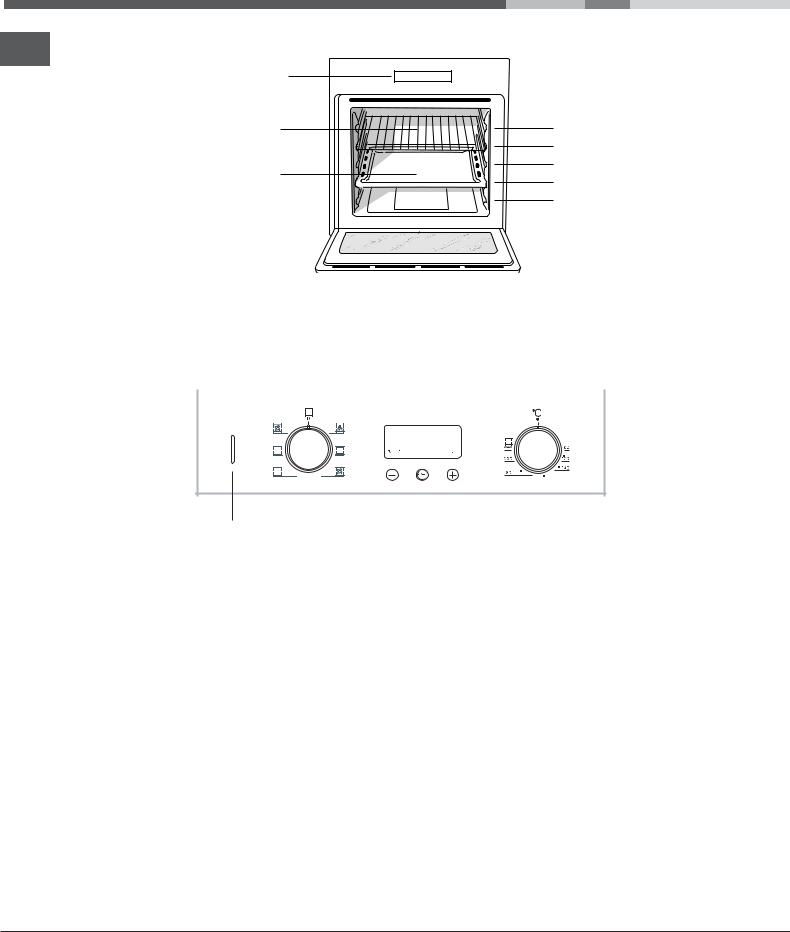
Descrizione dell’apparecchio
Vista d’insieme
IT
Pannello di controllo |
GUIDE di |
|
|
scorrimento dei |
|
|
ripiani |
|
Ripiano GRIGLIA |
posizione 5 |
|
|
posizione 4 |
|
Ripiano LECCARDA |
posizione 3 |
|
posizione 2 |
||
|
||
|
posizione 1 |
Pannello di controllo
|
|
|
Manopola |
Programmatore |
Manopola |
|||
|
|
|
PROGRAMMI |
ELETTRONICO |
TERMOSTATO |
|||
|
|
|
|
|
|
|
|
|
|
|
|
|
|
|
|
|
|
|
|
|
|
|
|
|
|
|
|
|
|
|
|
|
|
|
|
 ••
•• ••
••
Spia di
TERMOSTATO
4

Avvio e utilizzo
Alla prima accensione fare funzionare il forno a vuoto per almeno un’ora con il termostato al massimo e a porta chiusa. Poi spegnere, aprire la porta del forno
e aerare il locale. L’odore che si avverte è dovuto all’evaporazione delle sostanze usate per proteggere il forno.
Avviare il forno
1.Selezionare il programma di cottura desiderato ruotando la manopola PROGRAMMI.
2.Scegliere la temperatura ruotando la manopola TERMOSTATO. Una lista con le cotture e le relative temperature consigliate è consultabile nella Tabella cottura (vedi Programmi).
3.La spia TERMOSTATO accesa indica la fase di riscaldamento fino alla temperatura impostata.
4.Durante la cottura è sempre possibile:
-modificare il programma di cottura agendo sulla manopola PROGRAMMI;
-modificare la temperatura agendo sulla manopola TERMOSTATO;
-interrompere la cottura riportando la manopola PROGRAMMI in posizione “0”.
Non appoggiare mai oggetti sul fondo del forno perché si rischiano danni allo smalto.
Porre sempre i recipienti di cottura sulla griglia in dotazione.
Ventilazione di raffreddamento
IT
Per ottenere una riduzione delle temperature esterne, alcuni modelli sono dotati di una ventola di raffreddamento. Questa genera un getto d’aria che esce tra il pannello di controllo e la porta del forno.
A fine cottura la ventola rimane attiva finché il forno non è sufficientemente freddo.
Luce del forno
Si accende selezionando  con la manopola PROGRAMMI. Rimane accesa quando si seleziona un programma di cottura.
con la manopola PROGRAMMI. Rimane accesa quando si seleziona un programma di cottura.
5

Programmi
Programmi di cottura
IT
Per tutti i programmi è impostabile una temperatura tra 60°C e MAX, tranne:
•GRILL (si consiglia di impostare solo su MAX);
•GRATIN (si consiglia di non superare la temperatura di 200°C).
Programma FORNO TRADIZIONALE
Si attivano i due elementi riscaldanti inferiore e superiore. Con questa cottura tradizionale è meglio utilizzare un solo ripiano: con più ripiani si ha una cattiva distribuzione della temperatura.
 Programma MULTICOTTURA
Programma MULTICOTTURA
Si attivano tutti gli elementi riscaldanti (superiore e inferiore) ed entra in funzione la ventola. Poiché il calore è costante in tutto il forno, l’aria cuoce e rosola il cibo in modo uniforme. È possibile utilizzare fino a un massimo di due ripiani contemporaneamente.
Programma FORNO SOPRA
Si accende l’elemento riscaldante superiore. Questa funzione può essere utilizzata per ritocchi di cottura.
Programma GRILL
Si accende l’elemento riscaldante superiore. La temperatura assai elevata e diretta del grill consente la immediata rosolatura superficiale dei cibi che, ostacolando la fuoriuscita dei liquidi, li mantiene più teneri internamente. La cottura al grill è particolarmente consigliata per quei piatti che necessitano di elevata temperatura superficiale: bistecche di vitello e manzo, entrecôte, filetto, hamburger etc... Alcuni esempi di utilizzo sono riportati al paragrafo “Consigli pratici per la cottura”. Effettuare le cotture con la porta del forno chiusa.
Programma GRATIN
Si attiva l’elemento riscaldante superiore ed entra in funzione la ventola. Unisce all’irradiazione termica unidirezionale, la circolazione forzata dell’aria all’interno del forno. Ciò impedisce la bruciatura superficiale degli alimenti aumentando il potere di penetrazione del calore. Effettuare le cotture con la porta del forno chiusa.
Consigli pratici di cottura
Nelle cotture ventilate non utilizzare le posizioni dei ripiani 1 e 5: sono investite direttamente dall’aria calda, che potrebbe provocare bruciature sui cibi delicati.
Nelle cotture GRILL e GRATIN, disporre
la leccarda in posizione 1 per raccogliere i residui di cottura (sughi e/o grassi).
MULTICOTTURA
•Utilizzare le posizioni dei ripiani 2 e 4, mettendo alla 2 i cibi che richiedono maggior calore.
•Disporre la leccarda in basso e la griglia in alto. GRILL
•Inserire la griglia in posizione 3 o 4, disponendo gli alimenti al centro della griglia.
•Si consiglia di impostare il livello di energia al massimo. Non allarmarsi se la resistenza superiore non resta costantemente accesa: il suo funzionamento è controllato da un termostato.
PIZZA
•Per una buona cottura della pizza ultilizzate il programma MULTICOTTURA.
•Utilizzare una teglia in alluminio leggero, appoggiandola sulla griglia in dotazione. Con la leccarda si allungano i tempi di cottura e difficilmente si ottiene una pizza croccante.
•Nel caso di pizze molto farcite è consigliabile inserire la mozzarella a metà cottura.
6

|
|
|
|
|
|
|
|
|
|
|
|
|
Tabella cottura |
|
|
|
|
|
|
|
|
|
|
|
|
|
|
|
|
|
IT |
||||
|
|
|
|
|
|
|
|
|
|
||
|
|
|
|
|
|
|
|
|
|
|
|
|
|
|
Peso |
Posizione |
Preriscaldamento |
Temperatura |
Durata |
|
|||
|
Programmi |
Alimenti |
cottura |
|
|
|
|
||||
|
(Kg) |
dei ripiani |
(minuti) |
consigliata |
|
||||||
|
|
|
(minuti) |
|
|
|
|
||||
|
|
|
|
|
|
|
|
||||
|
|
|
|
|
|
|
|
|
|
|
|
|
|
Anatra |
1 |
3 |
15 |
200 |
65-75 |
|
|
|
|
|
Forno |
Arrosto di vitello o manzo |
1 |
3 |
15 |
200 |
70-75 |
|
|
|
|
|
Arrosto di maiale |
1 |
3 |
15 |
200 |
70-80 |
|
|
|
|
|
|
Tradizionale |
|
|
|
|
||||||
|
Biscotti (di frolla) |
- |
3 |
15 |
180 |
15-20 |
|
|
|
|
|
|
|
|
|
|
|
||||||
|
|
Crostate |
1 |
3 |
15 |
180 |
30-35 |
|
|
|
|
|
|
|
|
|
|
|
|
|
|
|
|
|
|
Pizza (su 2 ripiani) |
1 |
2 e 4 |
15 |
230 |
15-20 |
|
|
|
|
|
|
Lasagne |
1 |
3 |
10 |
180 |
30-35 |
|
|
|
|
|
|
Agnello |
1 |
2 |
10 |
180 |
40-45 |
|
|
|
|
|
|
Pollo arrosto + patate |
1+1 |
2 e 4 |
15 |
200 |
60-70 |
|
|
|
|
|
|
Sgombro |
1 |
2 |
10 |
180 |
30-35 |
|
|
|
|
|
Multicottura |
Plum-cake |
1 |
2 |
10 |
170 |
40-50 |
|
|
|
|
|
|
Bignè (su 2 ripiani) |
0.5 |
2 e 4 |
10 |
190 |
20-25 |
|
|
|
|
|
|
Biscotti(su 2 ripiani) |
0.5 |
2 e 4 |
10 |
180 |
10-15 |
|
|
|
|
|
|
Pan di spagna (su 1 ripiano) |
0.5 |
2 |
10 |
170 |
15-20 |
|
|
|
|
|
|
Pan di spagna (su 2 ripiani) |
1 |
2 e 4 |
10 |
170 |
20-25 |
|
|
|
|
|
|
Torte salate |
1.5 |
3 |
15 |
200 |
25-30 |
|
|
|
|
|
|
|
|
|
|
|
|
|
|
|
|
|
Forno Sopra |
Ritocchi di cottura |
- |
3/4 |
15 |
220 |
- |
|
|
|
|
|
|
|
|
|
|
|
|
|
|
|
|
|
|
Sogliole e seppie |
1 |
4 |
5 |
Max |
8-10 |
|
|
|
|
|
|
Spiedini di calamari e gamberi |
1 |
4 |
5 |
Max |
6-8 |
|
|
|
|
|
|
Filetto di merluzzo |
1 |
4 |
5 |
Max |
10 |
|
|
|
|
|
|
Verdure alla griglia |
1 |
3/4 |
5 |
Max |
10-15 |
|
|
|
|
|
Grill |
Bistecca di vitello |
1 |
4 |
5 |
Max |
15-20 |
|
|
|
|
|
|
Cotolette |
1 |
4 |
5 |
Max |
15-20 |
|
|
|
|
|
|
Hamburger |
1 |
4 |
5 |
Max |
7-10 |
|
|
|
|
|
|
Sgombri |
1 |
4 |
5 |
Max |
15-20 |
|
|
|
|
|
|
Toast |
n.° 4 |
4 |
5 |
Max |
2-3 |
|
|
|
|
|
|
|
|
|
|
|
|
|
|
|
|
|
Gratin |
Pollo alla griglia |
1.5 |
2 |
5 |
200 |
55-60 |
|
|
|
|
|
Seppie |
1.5 |
2 |
5 |
200 |
30-35 |
|
|
|
|
|
|
|
|
|
|
|
||||||
|
|
|
|
|
|
|
|
|
|
|
|
7
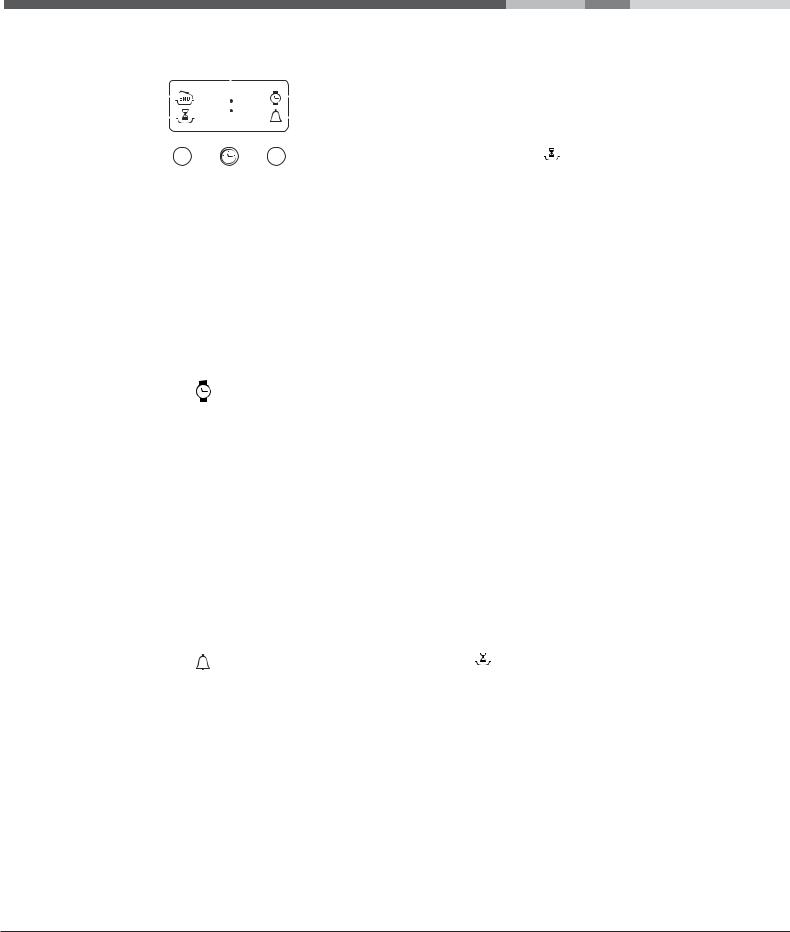
Il programmmatore di cottura elettronico
IT |
|
|
|
|
|
|
|
|
|
|
|
|
|
|
|
|
|
|
|
|
|
DISPLAY |
|
||||||
|
|
|
|
|
|
|
|
|
|
|
|
|
|
Icona |
|
|
|
|
|
|
|
|
|
|
|
|
|||
|
|
Icona |
|
|
|
|
|
|
|
|
|
|
||
|
|
Icona |
|
•• •• |
Icona |
|||||||||
|
|
FINE COTTURA |
|
|
|
|
|
|
|
|
|
|
OROLOGIO |
|
|
|
DURATA |
|
|
|
|
|
|
|
|
CONTAMINUTI |
|||
|
|
Tasto |
|
|
|
|
|
|
|
|
|
|
|
Tasto |
|
|
|
|
|
|
|
|
|
|
|
|
|
||
|
|
DIMINUZIONE |
|
|
|
|
|
|
|
|
AUMENTO |
|||
|
|
TEMPI |
|
|
Tasto |
TEMPI |
||||||||
|
|
|
|
|
|
|
|
IMPOSTAZIONE |
|
|||||
|
|
|
|
|
|
|
|
TEMPI |
|
|||||
|
|
|
|
|
|
|
|
|
||||||
|
|
|
|
|
|
|
|
|
|
|
|
|
|
|
Impostare l’orologio
Si può impostare sia quando il forno è spento che quando è acceso, ma non si è programmata la fine di una cottura.
Dopo l’allacciamento alla rete elettrica o dopo un
black-out, l’icona  e i quattro digit numerici sul DISPLAY lampeggiano.
e i quattro digit numerici sul DISPLAY lampeggiano.
1. Premere più volte il tasto 
 finchè non
finchè non
lampeggiano l’icona |
e i quattro digit numerici sul |
DISPLAY; |
|
2.con i tasti “+” e “-” regolare l’ora; se si tengono premuti, i numeri scorrono più velocemente per facilitare l’impostazione.
3.attendere 10 sec oppure premere nuovamente il
tasto 
 per fissare l’impostazione.
per fissare l’impostazione.
Impostare il contaminuti
Questa funzione non interrompe la cottura e prescinde dall’utilizzo del forno; permette solo di azionare il segnale acustico allo scadere dei minuti impostati.
1. Premere più volte il tasto 
 finchè non
finchè non
lampeggiano l’icona |
e i tre digit numerici sul |
DISPLAY; |
|
2.con i tasti “+” e “-” regolare il tempo desiderato; se si tengono premuti, i numeri scorrono più velocemente per facilitare l’impostazione.
3.attendere 10 sec oppure premere nuovamente il
tasto 
 per fissare l’impostazione.
per fissare l’impostazione.
Seguirà la visualizzazione del conto alla rovescia al termine del quale si azionerà il segnale acustico.
Programmare la cottura
La programmazione è possibile solo dopo aver selezionato un programma di cottura.
Programmare la durata di cottura
1. Premere più volte il tasto 
 finchè non lampeggiano l’icona e i tre digit numerici sul DISPLAY;
finchè non lampeggiano l’icona e i tre digit numerici sul DISPLAY;
2.con i tasti “+” e “-” regolare la durata desiderata; se si tengono premuti, i numeri scorrono più velocemente per facilitare l’impostazione.
3.attendere 10 sec oppure premere nuovamente il
tasto 
 per fissare l’impostazione.
per fissare l’impostazione.
4. a tempo scaduto, sul DISPLAY compare la scritta END, il forno termina la cottura e viene emesso un segnale acustico.
•Esempio: sono le 9:00 e viene programmata una durata di 1 ora e 15 minuti. Il programma si arresta automaticamente alle 10:15.
Programmare la fine di una cottura
La programmazione della fine di una cottura è possibile solo dopo aver impostato una durata di cottura.
1.Seguire la procedura da 1 a 3 descritta per la durata;
2.poi premere il tasto 
 finchè non lampeggiano
finchè non lampeggiano
l’icona  e i quattro digit numerici sul DISPLAY;
e i quattro digit numerici sul DISPLAY;
3.con i tasti “+” e “-” regolare l’ora di fine cottura desiderata; se si tengono premuti i numeri, scorrono più velocemente per facilitare l’impostazione.
4.attendere 10 sec oppure premere nuovamente il
tasto 
 per fissare l’impostazione.
per fissare l’impostazione.
5. a tempo scaduto, sul DISPLAY compare la scritta END, il forno termina la cottura e viene emesso un segnale acustico.
Le icone e  accese segnalano che è stata effettuata una programmazione. Sul DISPLAY vengono visualizzate alternativamente l’ora di fine cottura e la durata.
accese segnalano che è stata effettuata una programmazione. Sul DISPLAY vengono visualizzate alternativamente l’ora di fine cottura e la durata.
Annulare una programmazione
Per annullare una programmazione:
•premere il tasto 
 finchè non lampeggia l’icona dell’impostazione da annullare e i digit sul display. Premere il tasto “-” finchè sul display non compaiono le cifre 00:00.
finchè non lampeggia l’icona dell’impostazione da annullare e i digit sul display. Premere il tasto “-” finchè sul display non compaiono le cifre 00:00.
•tenere premuti contemporaneamente i tasti “+” e ”-”; in questo modo si annullano tutte le programmazioni effettuate contaminuti compreso.
8

Precauzioni e consigli
L’apparecchio è stato progettato e costruito in conformità alle norme internazionali di sicurezza. Queste avvertenze sono fornite per ragioni di sicurezza e devono essere lette attentamente.
Sicurezza generale
•L’apparecchio è stato concepito per un uso di tipo non professionale all’interno dell’abitazione.
•L’apparecchio non va installato all’aperto, nemmeno se lo spazio è riparato, perché è molto pericoloso lasciarlo esposto a pioggia e temporali.
•Per movimentare l’apparecchio servirsi sempre delle apposite maniglie poste sui fianchi del forno.
•Non toccare la macchina a piedi nudi o con le mani o i piedi bagnati o umidi.
•L’apparecchio deve essere usato per cuocere alimenti, solo da persone adulte e secondo le istruzioni riportate in questo libretto.
•Durante l'uso dell'apparecchio gli elementi riscaldanti e alcune parti della porta forno
diventano molto calde. Fare attenzione a non toccarle e tenere i bambimi a distanza.
•Evitare che il cavo di alimentazione di altri elettrodomestici entri in contatto con parti calde del forno.
•Non ostruire le aperture di ventilazione e di smaltimento di calore.
•Impugnare la maniglia di apertura della porta al centro: ai lati potrebbe essere calda.
•Utilizzare sempre guanti da forno per inserire o estrarre recipienti.
•Non rivestire il fondo del forno con fogli di alluminio.
•Non riporre materiale infiammabile nel forno: se l’apparecchio viene messo inavvertitamente in funzione potrebbe incendiarsi.
•Assicurarsi sempre che le manopole siano nella posizione “l”/“¡” quando l’apparecchio non è utilizzato.
•Non staccare la spina dalla presa della corrente tirando il cavo, bensì afferrando la spina.
• Non fare pulizia o manutenzione senza aver prima staccato |
IT |
|
la spina dalla rete elettrica. |
||
|
||
|
|
•In caso di guasto, in nessun caso accedere ai meccanismi interni per tentare una riparazione. Contattare l’Assistenza (vedi Assistenza).
•Non appoggiare oggetti pesanti sulla porta del forno aperta.
•Evitare che i bambini giochino con l'apparecchio.
•Non è previsto che l'apparecchio venga utilizzato da persone (bambini compresi) con ridotte capacità fisiche, sensoriali o mentali, da persone inesperte o che non abbiano familiarità con il prodotto, a meno che non vengano sorvegliate da una persona responsabile della loro sicurezza o non abbiano ricevuto istruzioni preliminari sull'uso dell'apparecchio.
Smaltimento
•Smaltimento del materiale di imballaggio: attenersi alle norme locali, così gli imballaggi potranno essere riutilizzati.
•La direttiva Europea 2002/96/CE sui rifiuti di apparecchiature elettriche ed elettroniche (RAEE), prevede che gli elettrodomestici non debbano essere smaltiti nel normale flusso dei rifiuti solidi urbani. Gli apparecchi dismessi devono essere raccolti separatamente per ottimizzare il tasso di recupero e riciclaggio dei materiali che li compongono ed impedire potenziali danni per la salute e l’ambiente. Il simbolo del cestino barrato è riportato su tutti i prodotti per ricordare gli obblighi di raccolta separata.
Per ulteriori informazioni, sulla corretta dismissione degli elettrodomestici, i detentori potranno rivolgersi al servizio pubblico preposto o ai rivenditori.
Risparmiare e rispettare l’ambiente
•Azionando il forno negli orari che vanno dal tardo pomeriggio fino alle prime ore del mattino si collabora a ridurre il carico di assorbimento delle aziende elettriche.
•Si raccomanda di effettuare sempre le cotture al GRILL e GRATIN a porta chiusa: sia per ottenere migliori risultati che per un sensibile risparmio di energia (10% circa).
•Mantenere efficienti e pulite le guarnizioni, in modo che aderiscano bene alla porta e non procurino dispersioni di calore.
9
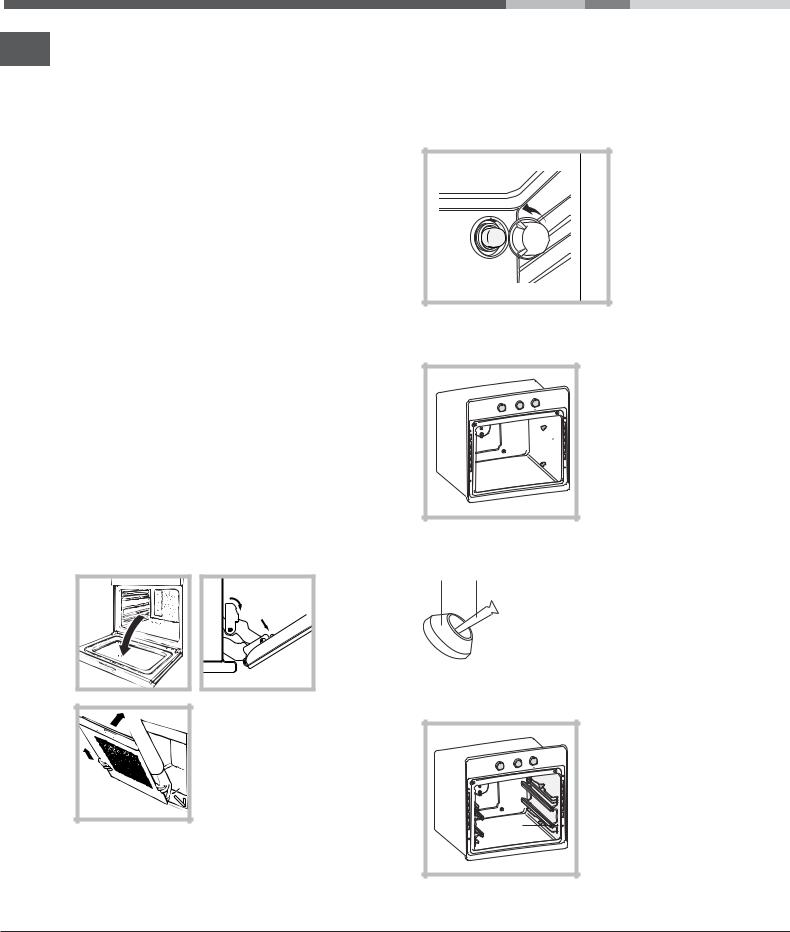
Manutenzione e cura
Escludere la corrente elettrica
IT
Prima di ogni operazione isolare l’apparecchio dalla rete di alimentazione elettrica.
rivolgersi al Centro Assistenza più vicino (vedi Assistenza). È consigliabile non usare il forno fino all’avvenuta riparazione.
Pulire l’apparecchio
•Le parti esterne smaltate o inox e le guarnizioni in gomma possono essere pulite con una spugnetta imbevuta di acqua tiepida, e sapone neutro. Se le macchie sono difficili da asportare usare prodotti specifici. Si consiglia di sciacquare abbondantemente e di asciugare dopo la pulizia. Non usare polveri abrasive o sostanze corrosive.
•L’interno del forno va pulito preferibilmente ogni volta dopo l’uso, quando è ancora tiepido. Usare acqua calda e detersivo, risciaquare e asciugare con un panno morbido. Evitare gli abrasivi.
•Gli accessori possono essere lavati come normali stoviglie, anche in lavastoviglie ad eccezione delle guide scorrevoli.
•Non utilizzare mai pulitori a vapore o ad alta pressione per la pulizia dell’apparecchio.
Pulire la porta
Pulire il vetro della porta con spugne e prodotti non abrasivi e asciugare con un panno morbido; non usare materiali ruvidi abrasivi o raschietti metallici affilati che possono graffiare la superficie e causare la frantumazione del vetro.
Per una pulizia più accurata è possibile smontare la porta del forno:
1.aprire completamente la porta (vedi figura);
2.alzare e ruotare le levette poste sulle due cerniere
(vedi figura);
F |
F |
3. afferrare la porta ai due lati esterni, richiudendola lentamente ma non del tutto. Premere i fermi F, poi tirare la porta verso di sé estraendola dalle cerniere (vedi figura). Rimontare la porta seguendo il procedimento in senso contrario.
Controllare le guarnizioni
Controllare periodicamente lo stato della guarnizione attorno alla porta del forno. In caso risulti danneggiata
Sostituire la lampadina
Per sostituire la lampadina di illuminazione del forno:
1.Svitare il coperchio in vetro del portalampada.
2.Svitare la
lampadina e sostituirla con una analoga: potenza 25 W, attacco E 14.
3. Rimontare il coperchio (vedi figura).
Montaggio del Kit Guide Scorrevoli
Per montare le guide scorrevoli:
|
1. Svitare le due viti A |
|
(vedi figura). Se il forno |
|
è dotato di pannelli |
|
autopulenti, essi |
A |
risulteranno |
|
momentaneamente |
A |
smontati. |
2. Sostituire le viti A con le viti e i distanzieri (B+C) forniti nel kit.
CB
3.Avvitare le nuove viti B e i relativi distanzieri C, rimontando anche i pannelli autopulenti.
D |
4. Fissare i due incastri D della guida negli appositi fori posti sulle pareti del forno (vedi figura). I fori per la guida sinistra sono posizionati in alto, mentre i fori per quella destra sono in basso.
5.Infine incastrare la guida sul distanziere C.
6.Non inserire le guide scorrevoli alla posizione 5.
10

Assistenza
|
|
|
|
|
Comunicare: |
|
|
||
IT |
||||
• |
il modello della macchina (Mod.) |
|||
• |
il numero di serie (S/N) |
|
|
|
|
|
|||
Queste ultime informazioni si trovano sulla targhetta caratteristiche posta sull’apparecchio e/o sull’imballo.
Assistenza Attiva 7 giorni su 7
Se nasce il bisogno di assistenza o manutenzione basta chiamare il Numero Unico Nazionale 199.199.199* per essere messi subito in contatto con il Centro Assistenza Tecnica più vicino al luogo da cui si chiama.
È attivo 7 giorni su 7, sabato e domenica compresi, e non lascia mai inascoltata una richiesta.
Estensione di garanzia Airbag
Airbag è il servizio esclusivo creato da Ariston che integra e prolunga nel tempo i contenuti della garanzia standard: con una modica cifra protegge il cliente da ogni imprevisto riguardante l’assistenza e la manutenzione dell’elettrodomestico. Per i 5 anni successivi alla data di acquisto il cliente che aderisce al programma Airbag avrà diritto gratuitamente a:
•l’intervento entro 48 ore dalla chiamata;
•il contributo per spese di trasferta del Tecnico (diritto di chiamata);
•la manodopera;
•le parti di ricambio originali;
•il trasporto dell’elettrodomestico non riparabile in loco.
Inoltre, qualora l’elettrodomestico non sia riparabile la garanzia prevede la sostituzione a prezzo agevolato in funzione dell’anzianità del prodotto.
* Al costo di 14,25 centesimi di Euro al minuto (iva inclusa) dal Lun. al Ven. dalle 08:00 alle 18:30, il Sab. dalle 08:00 alle 13:00 e di 5,58 centesimi di Euro al minuto (iva inclusa) dal Lun. al Ven. dalle 18:30 alle 08:00, il Sab. dalle 13:00 alle 08:00 e i giorni festivi, per chi chiama dal telefono fisso.
Per chi chiama da radiomobile le tariffe sono legate al piano tariffario dell’operatore telefonico utilizzato.
Le suddette tariffe potrebbero essere soggette a variazione da parte dell’operatore telefonico; per maggiori informazioni consultare il sito www.aristonchannel.com.
11

Operating Instructions
OVEN
GB
Contents
|
|
|
|
|
|
Installation, 13-14 |
|
IT |
|
GB |
|
FR |
|
||
|
|
|
Positioning |
||||
|
|
|
|
|
|
Electrical connections |
|
Italiano, 1 |
English,12 |
Français, 22 |
|||||
Data plate |
|||||||
ES |
|
PT |
|
NL |
|
|
|
|
|
|
|
Espanol, 32 |
Portuges, 42 |
Nederlands, 52 |
|||
|
|
|
|
|
|
DE |
|
|
|
|
|
|
|
|
|
|
|
Deutsch, 62 |
|
|
|
|
|
Description of the appliance, 15
Overall view Control panel
Start-up and use, 16
Starting the oven
Cooking modes, 17-18
Cooking modes
Practical cooking advice
Cooking advice table
F 532 C.1/HA
F 532 C.1 IX/HA F 53 C.1/HA
F 53 C.1 IX/HA
The electronic cooking programmer, 19
Precautions and tips, 20
General safety Disposal
Respecting and conserving the environment Assistance
Maintenance and care, 21
Switching the appliance off Cleaning the appliance Cleaning the oven door Replacing the light bulb Sliding Rack Kit assembly
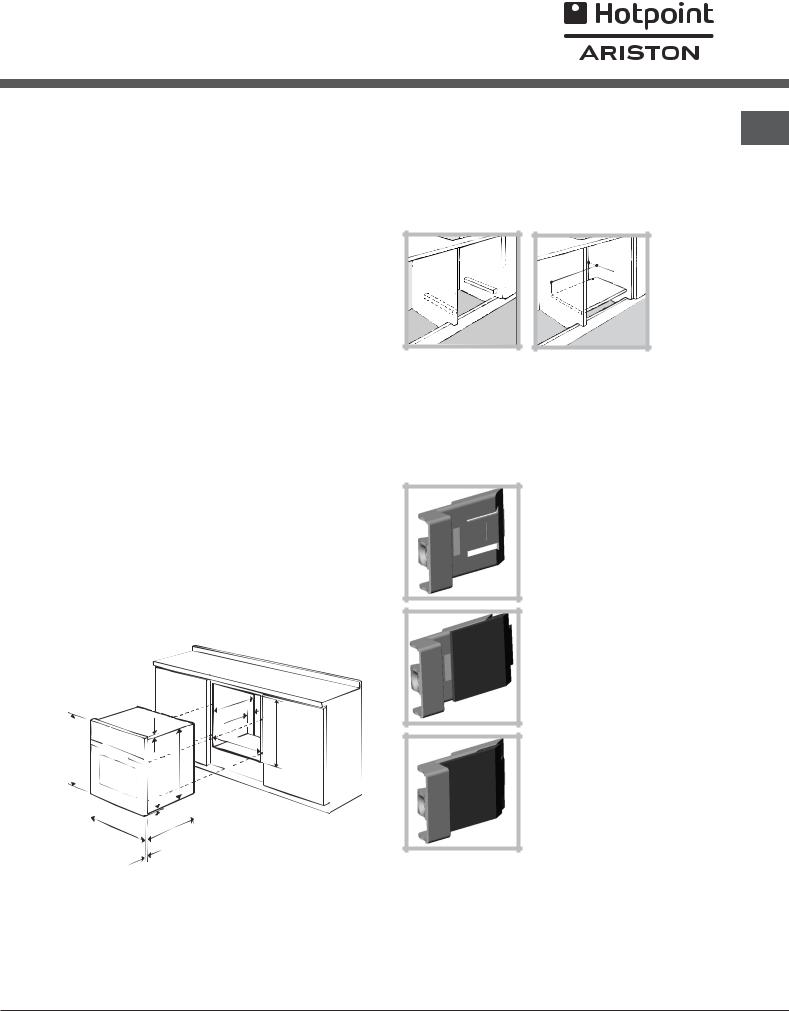
Installation
Before placing your new appliance into operation please read these operating instructions carefully. They contain important information for safe use, for installation and for care of the appliance.
Please keep these operating instructions for future reference. Pass them on to possible new owners of the appliance.
Positioning
Keep packaging material out of the reach of children. It can become a choking or suffocation hazard. (see Precautions and tips).
The appliance must be installed by a qualified person in compliance with the instructions provided. Incorrect installation may cause harm to persons, animals or may damage property.
Fitting the appliance
Use the appropriate cabinet to ensure that the appliance functions properly.
•The panels adjacent to the oven must be made of heat-resistant material.
•Cabinets with a veneer exterior must be assembled with glues which can withstand temperatures of up to 100°C.
•to install the oven under the counter (see diagram) and in a kitchen unit, the cabinet must have the following dimensions:
|
23 mm. |
595 mm. |
567 mm. |
|
5 mm. |
595 |
|
m |
|
mm. |
. |
|
m |
|
|
|
545 |
|
. |
|
|
m |
|
|
m |
|
24 |
|
|
|
|
|
|
. |
|
|
|
in |
|
|
|
.m |
|
|
|
m |
|
|
|
|
m |
|
|
|
547 |
|
|
|
|
|
|
|
. |
|
45 |
mm |
|
||
|
|
|
|
|
|
558 |
mm. |
||
|
|
|
||
593 mm.
The appliance must not come into contact with electrical parts once it has been installed.
The consumption indications on the data plate have been calculated for this type of installation.
Ventilation
GB
To ensure good ventilation, the back panel of the cabinet must be removed. It is advisable to install the oven so that it rests on two strips of wood, or on a completely flat surface with an opening of at least 45 x
560 mm (see diagrams).
. |
45 |
mm |
|
m |
|
. |
|
m |
|
|
|
560 |
|
|
|
Centring and fastening
Position the 4 tabs on the side of the oven according to the 4 holes of the outer frame. Adjust the tabs according to the thickness of the cabinet side panel, as shown below:
thickness of 20 mm: take off the removable part of the tab (see diagram)
thickness of 18 mm: use the first groove, which has already been set in the factory (see
diagram)
thickness of 16 mm: use the second groove (see diagram)
Secure the appliance to the cabinet by opening the oven door and putting 4 screws into the 4 holes of the outer frame.
! All parts which ensure the safe operation of the appliance must not be removable without the aid of a tool.
13
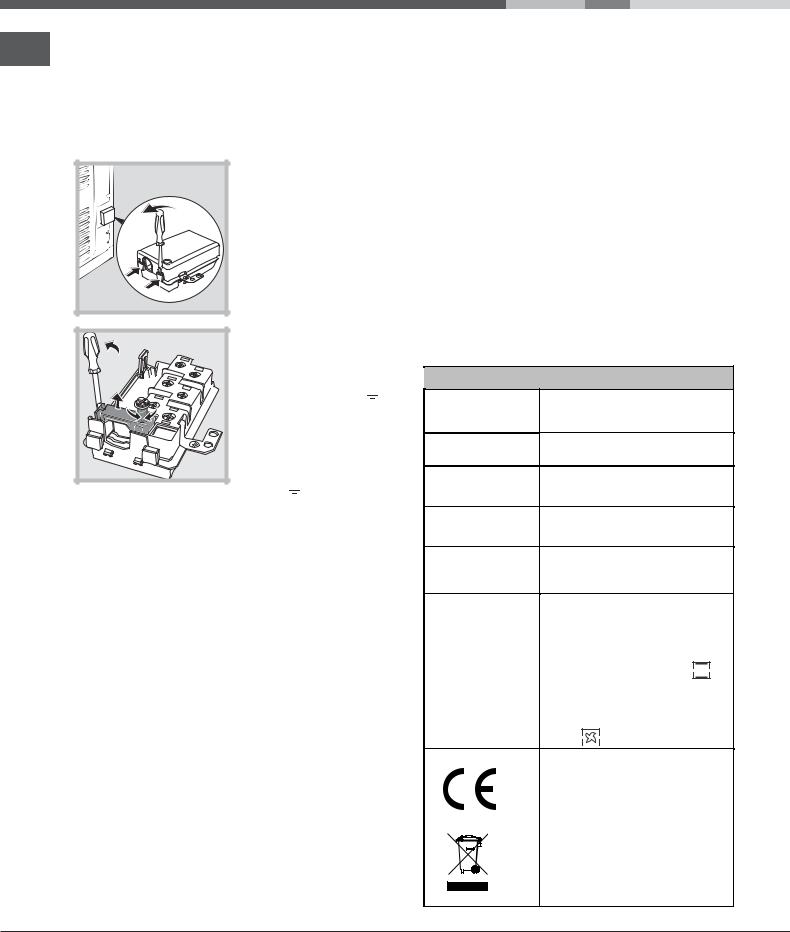
Electrical connections
GB
! Ovens equipped with a three-pole power supply cable are designed to operate with alternating current at the voltage and frequency indicated on the data plate located on the appliance (see below).
Fitting the power supply cable
1. Open the terminal board by inserting a screwdriver into the side tabs of the cover. Use the screwdriver as a lever by pushing it down to open the cover
(see diagram).
2. Loosen the cable clamp screw and remove it, using a screwdriver as a lever (see figure).
3. Remove the wire contact screws L-N-  , then fasten the wires under the screw heads, respecting the colour code: Blue (N), Brown
, then fasten the wires under the screw heads, respecting the colour code: Blue (N), Brown
(L) and Yellow-Green Verde ( ).
).
Connecting the supply cable to the mains
Install a standardised plug corresponding to the load indicated on the data plate (see side).
The appliance must be directly connected to the mains using an omnipolar circuit-breaker with a minimum contact opening of 3 mm installed between the appliance and the mains, suitable for the load indicated and complying with current electrical regulations (the earthing wire must not be interrupted by the circuit-breaker). The supply cable must not come into contact with surfaces with temperatures higher than 50°C.
! The installer must ensure that the correct electrical connection has been made and that it is compliant with safety regulations.
Before connecting to the power supply, make sure that:
•The appliance is earthed and the plug is compliant with the law.
•The socket can withstand the maximum power of the appliance, which is indicated on the data plate (see below).
•The voltage must be in the range between the values indicated on the data plate (see below).
•The socket is compatible with the plug of the appliance. If the socket is incompatible with the plug, ask an authorised technician to replace it. Do not use extension cords or multiple sockets.
!Once the appliance has been installed, the power supply cable and the electrical socket must be easily accessible.
!The cable must not be bent or compressed.
!The cable must be checked regularly and replaced by authorised technicians only (see Assistance).
!The manufacturer declines any liability should
these safety measures not be observed.
 DATA PLATE
DATA PLATE
width cm 43.5
Dimensions height cm 32 depth cm 41.5
Volume |
lt. 58 |
|
|
Dimensions of |
width cm 37.5 |
||
models with |
height cm 32 |
||
removable racks |
depth cm 41.5 |
||
Volume of models |
|
|
|
with removable |
lt. 50 |
|
|
racks |
|
|
|
Electrical |
voltage: 220-230V ~ 50/60 Hz or |
||
50Hz |
(see data plate) |
||
connections |
|||
maximum power absorbed 2250W |
|||
|
|||
|
Directive 2002/40/EC on the label |
||
|
of electric ovens. |
||
|
Standard EN 50304 |
||
|
Energy consumption for Natural |
||
ENERGY LABEL |
convection – heating mode: |
||
Convection mode |
|||
|
|||
|
Declared energy consumption for |
||
|
Forced convection Class – heating |
||
|
mode: |
Multi-cooking |
|
|
This appliance conforms to the |
||
|
following European Economic |
||
|
Community directives: |
||
|
- 2006/95/EEC of 12/12/06 (Low |
||
|
Voltage) and subsequent |
||
|
amendments; |
||
|
-89/336/EEC of 03/05/89 |
||
|
(Electromagnetic Compatibility) and |
||
|
subsequent amendments; |
||
|
- 93/68/EEC of 22/07/93 and |
||
|
subsequent amendments. |
||
|
- 2002/96/EC |
||
14
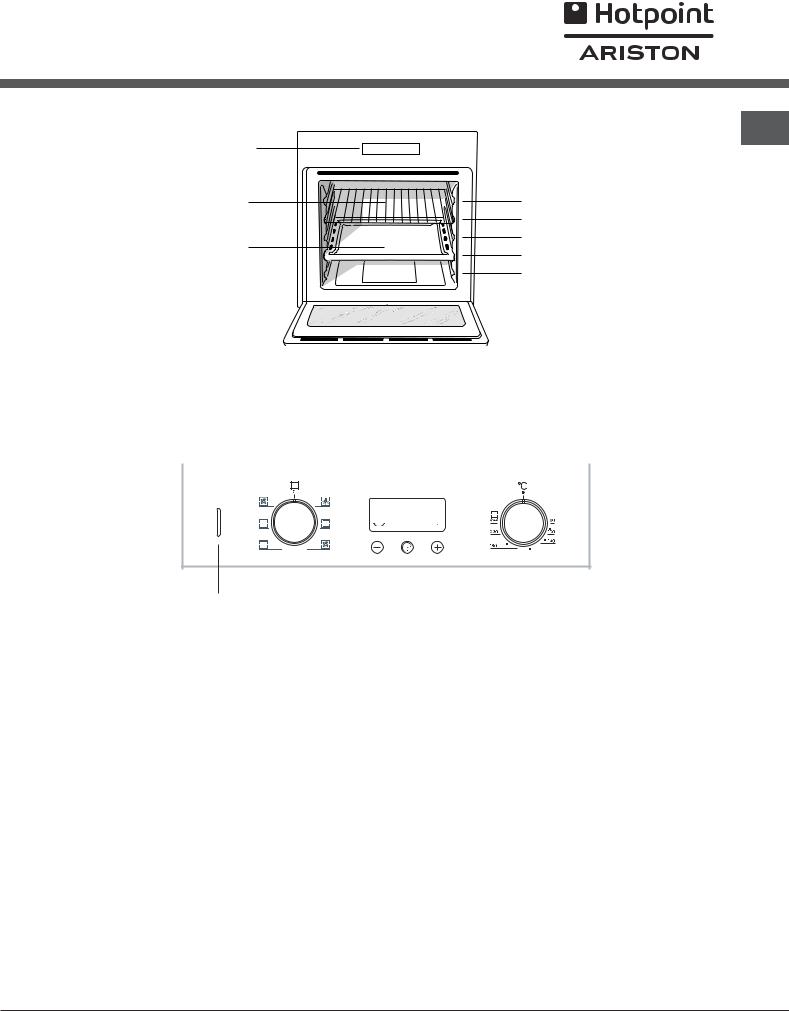
Description of the appliance
Overall view
GB
Control panel |
GUIDES for the |
|
|
sliding racks |
|
GRILL |
position 5 |
|
|
position 4 |
|
DRIPPING PAN |
position 3 |
|
position 2 |
||
|
||
|
position 1 |
Control panel
|
|
|
SELECTOR |
ELECTRONIC |
THERMOSTAT |
|||
|
|
|
Knob |
Programmer |
Knob |
|||
|
|
|
|
|
|
|
|
|
|
|
|
|
|
|
|
|
|
|
|
|
|
|
|
|
|
|
 ••
•• ••
••
Indicator light
THERMOSTAT
15

Start-up and use
! The first time you use your appliance, heat the GB empty oven with its door closed at its maximum
temperature for at least half an hour. Ensure that the room is well ventilated before switching the oven off and opening the oven door. The appliance may produce a slightly unpleasant odour caused by the burning away of protective substances used during the manufacturing process.
Starting the oven
1.Select the desired cooking mode by turning the SELECTOR knob.
2.Select the desired temperature with the
THERMOSTAT knob. See the Cooking advice table for cooking modes and the suggested cooking temperatures (see Cooking Modes).
3.When preheating is finished, the THERMOSTAT indicator light will stay on: place the food in the oven.
4.You may do the following during cooking:
-change the cooking mode by turning the SELECTOR knob.
-change the temperature by turning the
THERMOSTAT knob.
- stop cooking by turning the SELECTOR knob to the “0” position.
!Never put objects directly on the oven bottom to avoid damaging the enamel coating.
!Always place cookware on the rack(s) provided.
Cooling ventilation
In order to cool down the external temperature of the oven, some models are fitted with a cooling fan that blows out air between the control panel and the oven door.
! Once the cooking has been completed, the cooling fan remains on until the oven has cooled down sufficiently.
Oven light
It goes on when selecting  with the SELECTOR knob. It stays on when a cooking mode is selected.
with the SELECTOR knob. It stays on when a cooking mode is selected.
16

Cooking modes
Cooking modes
! A temperature value can be set for all cooking modes between 60°C and Max, except for
•GRILL (recommended: set only to MAX power level);
•GRATIN (recommended: do not exceed 200°C).
 TRADITIONAL OVEN mode
TRADITIONAL OVEN mode
Both the top and bottom heating elements will come on. With this traditional cooking mode, it is best to use one cooking rack only; if more than one rack is used, the heat will be distributed unevenly.
 MULTI-COOKING mode
MULTI-COOKING mode
All the heating elements (top and bottom), as well as the fan, will come on. Since the heat remains constant throughout the oven, the air cooks and browns food uniformly. A maximum of two racks may be used at the same time.
 TOP OVEN mode
TOP OVEN mode
The top heating element comes on. This mode can be used to brown food at the end of cooking.
 GRILL mode
GRILL mode
The top heating element comes on. The extremely high and direct temperature of the grill makes it possible to brown the surface of meats and roasts while locking in the juices to keep them tender. The grill is also highly recommended for dishes that require a high temperature on the surface: such as beef steaks, veal, rib steak, filets, hamburgers etc...
Some grilling examples are included in the “Practical Cooking Advice” paragraph. Always cook in this mode with the oven door closed.
GRATIN mode |
GB |
The top heating element, as well as the fan, will come on. This combination of features increases the effectiveness of the unidirectional thermal radiation of the heating elements through forced circulation of the air throughout the oven. This helps prevent food from burning on the surface, allowing the heat to penetrate right into the food. Always cook in this mode with the oven door closed.
Practical cooking advice
!Do not place racks in position 1 and 5 during fanassisted cooking. Excessive direct heat can burn temperature sensitive foods.
!In the GRILL and GRATIN cooking modes, place the dripping pan in position 1 to collect cooking residues (fat and/or grease).
MULTI-COOKING
•Use position 2 and 4, placing the food that requires more heat on 2.
•Place the dripping pan on the bottom and the rack on top.
GRILL
•Insert the rack in position 3 or 4. Place the food in the centre of the rack.
•We recommend that you set the maximum power level. The top heating element is regulated by a thermostat and may not always be on.
PIZZA
•For best results when cooking pizza, use the MULTI-COOKING mode.
•Use a light aluminium pizza pan. Place it on the rack provided.
For a crispy crust, do not use the dripping pan (prevents crust from forming by extending cooking time).
•If the pizza has a lot of toppings, we recommend adding the mozzarella cheese on top of the pizza halfway through the cooking process.
17

Cooking advice table
GB
Cooking |
|
Weight |
Rack |
Pre- |
Recommended |
Cooking |
|
Foods |
heating |
time |
|||||
modes |
(in kg) |
position |
temperature |
||||
|
time (min) |
(minutes) |
|||||
|
|
|
|
|
|||
|
Duck |
1 |
3 |
15 |
200 |
65-75 |
|
Convection |
Roast veal or beef |
1 |
3 |
15 |
200 |
70-75 |
|
Pork roast |
1 |
3 |
15 |
200 |
70-80 |
||
Oven |
|||||||
Biscuits (short pastry) |
- |
3 |
15 |
180 |
15-20 |
||
|
Tarts |
1 |
3 |
15 |
180 |
30-35 |
|
|
Pizza (on 2 racks) |
1 |
2 and 4 |
15 |
230 |
15-20 |
|
|
Lasagne |
1 |
3 |
10 |
180 |
30-35 |
|
|
Lamb |
1 |
2 |
10 |
180 |
40-45 |
|
|
Roast chicken + potatoes |
1+1 |
2 and 4 |
15 |
200 |
60-70 |
|
Multi-cooking |
Mackerel |
1 |
2 |
10 |
180 |
30-35 |
|
Plum cake |
1 |
2 |
10 |
170 |
40-50 |
||
|
Cream puffs (on 2 racks) |
0.5 |
2 and 4 |
10 |
190 |
20-25 |
|
|
Biscuits (on 2 racks) |
0.5 |
2 and 4 |
10 |
180 |
10-15 |
|
|
Sponge cake (on 1 rack) |
0.5 |
2 |
10 |
170 |
15-20 |
|
|
Sponge cake (on 2 racks) |
1 |
2 and 4 |
10 |
170 |
20-25 |
|
|
Savoury pies |
1.5 |
3 |
15 |
200 |
25-30 |
|
Top oven |
Browning food to perfect cooking |
- |
3/4 |
15 |
220 |
- |
|
|
|
|
|
|
|
|
|
|
Soles and cuttlefish |
1 |
4 |
5 |
Max |
8-10 |
|
|
Squid and prawn kebabs |
1 |
4 |
5 |
Max |
6-8 |
|
|
Cod filet |
1 |
4 |
5 |
Max |
10 |
|
Grill |
Grilled vegetables |
1 |
3 or 4 |
5 |
Max |
10-15 |
|
Veal steak |
1 |
4 |
5 |
Max |
15-20 |
||
|
Cutlets |
1 |
4 |
5 |
Max |
15-20 |
|
|
Hamburgers |
1 |
4 |
5 |
Max |
7-10 |
|
|
Mackerels |
1 |
4 |
5 |
Max |
15-20 |
|
|
Toasts |
4 |
4 |
5 |
Max |
2-3 |
|
Gratin |
Grilled chicken |
1.5 |
2 |
5 |
200 |
55-60 |
|
Cuttlefish |
1.5 |
2 |
5 |
200 |
30-35 |
||
|
18
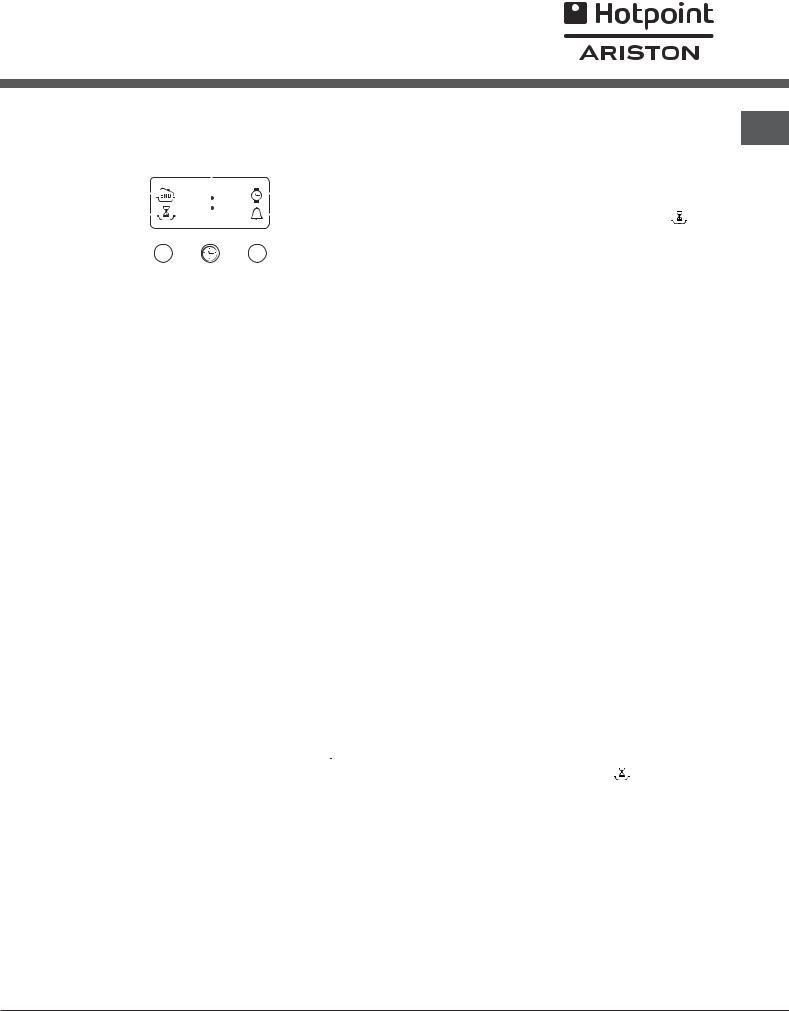
The electronic cooking
programmer
|
|
|
|
|
|
DISPLAY |
|
|
|
|
|
|
|
|
|
|
|
|
|
|
|
|
|
||
|
|
|
|
|
|
|
|
|
|
|
||
END OF |
|
|
|
•• •• |
|
|
|
|
CLOCK icon |
|||
|
|
|
|
|
|
|
|
|
||||
COOKING icon |
|
|
|
|
|
|
||||||
DURATION |
|
|
|
|
|
|
|
TIMER icon |
||||
|
|
|
|
|
|
|||||||
icon |
|
|
|
|
|
|
|
|
|
|||
DECREASE TIME |
|
|
|
|
|
|
|
|
|
|
|
INCREASE TIME |
|
|
|
|
|
|
|
|
|
|
|
||
|
|
|
|
|
|
|
|
|
||||
button |
|
|
SET TIME |
|
|
|
|
button |
||||
|
|
|
|
|
|
|
|
|
|
|
||
|
|
|
|
|
|
button |
|
|
|
|
|
|
|
|
|
|
|
|
|
|
|
|
|
||
|
|
|
|
|
|
|
|
|
|
|
|
|
Setting the clock
The clock may be set when the oven is switched off or when it is switched on, provided that a the end time of a cooking cycle has not been programmed previously.
After the appliance has been connected to the
mains, or after a blackout, the  icon and the four numerical digits on the DISPLAY will begin to flash.
icon and the four numerical digits on the DISPLAY will begin to flash.
1.Press the 
 button several times until the
button several times until the  icon and the four digits on the display begin to flash.
icon and the four digits on the display begin to flash.
2.Use the “+” and “-” buttons to adjust the time; if you press and hold either button, the display will scroll through the values more quickly, making it quicker and easier to set the desired value.
3.Wait for 10 seconds or press the 
 button again to finalise the setting.
button again to finalise the setting.
Setting the timer
This function does not interrupt cooking and does not affect the oven; it is simply used to activate the buzzer when the set amount of time has elapsed.
1.Press the 
 button several times until the
button several times until the  icon and the three digits on the display begin to flash.
icon and the three digits on the display begin to flash.
2.Use the “+” and “-” buttons to set the desired time; if you press and hold either button, the display will scroll through the values more quickly, making it quicker and easier to set the value.
3.Wait for 10 seconds or press the 
 button again to finalise the setting.
button again to finalise the setting.
The display will then show the time as it counts down. When this period of time has elapsed the buzzer will be activated.
Programming cooking
GB
A cooking mode must be selected before programming can take place.
Programming the cooking duration
1. Press the 
 button several times until the icon and the three digits on the DISPLAY begin to flash.
button several times until the icon and the three digits on the DISPLAY begin to flash.
2.Use the “+” and “-” buttons to set the desired duration; if you press and hold either button, the display will scroll through the values more quickly, making it quicker and easier to set the value.
3.Wait for 10 seconds or press the 
 button again to finalise the setting.
button again to finalise the setting.
4.When the set time has elapsed, the text END appears on the DISPLAY, the oven will stop cooking and a buzzer sounds.
• For example: it is 9:00 a.m. and a time of 1 hour and 15 minutes is programmed. The programme will stop automatically at 10:15 a.m.
Setting the end time for a cooking mode
A cooking duration must be set before the cooking end time can be scheduled.
1.Follow steps 1 to 3 to set the duration as detailed above.
2.Next, press the 
 button until the
button until the  icon and the four digits on the DISPLAY begin to flash.
icon and the four digits on the DISPLAY begin to flash.
3.use the “+” and “-” buttons to adjust the cooking end time; if you press and hold either button, the display will scroll through the values more quickly, making it quicker and easier to set the desired value.
4.Wait for 10 seconds or press the 
 button again to finalise the setting.
button again to finalise the setting.
5.When the set time has elapsed, the text END appears on the DISPLAY, the oven will stop cooking and a buzzer sounds.
Programming has been set when the and  buttons are illuminated. The DISPLAY shows the cooking end time and the cooking duration alternately.
buttons are illuminated. The DISPLAY shows the cooking end time and the cooking duration alternately.
Cancelling a programme
To cancel a programme:
•press the 
 button until the icon corresponding to the setting you wish to cancel and the digits on the display are no longer flashing. Press the “-” button until the digits 00:00 appear on the display.
button until the icon corresponding to the setting you wish to cancel and the digits on the display are no longer flashing. Press the “-” button until the digits 00:00 appear on the display.
•Press and hold the “+” and “-” buttons; this will cancel all the settings selected previously, including timer settings.
19

Precautions and tips
!Theappliancewasdesignedandmanufacturedincompliancewith GB internationalsafetystandards.Thefollowingwarningsareprovidedfor
safetyreasonsandmustbereadcarefully.
General safety
•Theappliancewasdesignedfordomesticuseinsidethehome andisnotintendedforcommercialorindustrialuse.
•Theappliancemustnotbeinstalledoutdoors,evenincovered areas.Itisextremelydangeroustoleavetheapplianceexposed torainandstorms.
•Whenhandlingtheappliance,alwaysusethehandlesprovided on the sides of the oven.
•Donottouchtheappliancewithbarefeetorwithwetormoist handsandfeet.
•Theappliancemustbeusedtocookfoodbyadultsonlyand accordingtotheinstructionsinthismanual.
•When the appliance is in use, the heating elements and some parts of the oven door become extremely hot. Make sure you don't touch them and keep children well away.
•Ensurethatthepowersupplycableofotherelectricalappliances does not come into contact with the hot parts of the oven.
•Theopeningsusedforventilationanddispersionofheatmust neverbecovered.
•Alwaysgriptheovendoorhandleinthecentre:theendsmaybe hot.
•Alwaysuseovenglovestoplacecookwareintheovenorwhen removingit.
•Donotusealuminiumfoiltolinethebottomoftheoven.
•Donotplaceflammablematerialsintheoven:iftheapplianceis switchedonbymistake,itcouldcatchfire.
•Alwaysmakesuretheknobsareinthe“l”/“¡”positionwhenthe applianceisnotinuse.
•Whenunpluggingtheappliancealwayspulltheplugfromthe mainssocket,donotpullonthecable.
•Nevercarryoutanycleaningormaintenanceworkwithouthaving unpluggedtheplugfromthemains.
•Inthecaseofamalfunction,undernocircumstancesshouldyou attempttorepairtheapplianceyourself.Repairscarriedoutby
inexperiencedpersonsmaycauseinjuryorfurthermalfunctioning oftheappliance.ContactaServiceCentre(seeAssistance).
•Donotrestheavyobjectsontheopenovendoor.
•Theapplianceshouldnotbeoperatedbypeople(including children)withreducedphysical,sensoryormentalcapacities,by inexperiencedindividualsorbyanyonewhoisnotfamiliarwiththe product.Theseindividualsshould,attheveryleast,besupervised bysomeonewhoassumesresponsibilityfortheirsafetyorreceive preliminaryinstructionsrelatingtotheoperationoftheappliance.
•Donotletchildrenplaywiththeappliance.
Disposal
•Observelocalenvironmentalstandardswhendisposingpackaging materialforrecyclingpurposes.Observeexistinglegislationwhen disposingoftheoldappliance.
•TheEuropeanDirective2002/96/EConWasteElectricaland ElectronicEquipment(WEEE),requiresthatoldhousehold electricalappliancesmustnotbedisposedofinthenormal unsortedmunicipalwastestream.Oldappliancesmustbe collectedseparatelyinordertooptimisetherecoveryand recyclingofthematerialstheycontainandreducetheimpacton humanhealthandtheenvironment.Thecrossedout“wheeled bin”symbolontheproductremindsyouofyourobligation,that whenyoudisposeoftheapplianceitmustbeseparately collected.
Consumersshouldcontacttheirlocalauthorityorretailerfor informationconcerningthecorrectdisposaloftheiroldappliance.
Respecting and conserving the environment
•Byusingtheapplianceinthehoursbetweenlateafternoonand earlymorning,youcanhelpreducetheworkloadplacedon electricalcompanies.
•AlwayskeeptheovendoorclosedwhenusingtheGRILLand GRATINmode toattainbestresultsandtosaveenergy (approximately10%).
•Regularlycheckthedoorsealsandwipecleantoensuretheyare freeofdebrissothattheystickproperlytothedooranddonot allowheattodisperse.
Assistance
Communicating:
•appliancemodel(Mod.)
•serialnumber(S/N)
Thisinformationisfoundonthedataplatelocatedontheappliance and/oronthepackaging.
20
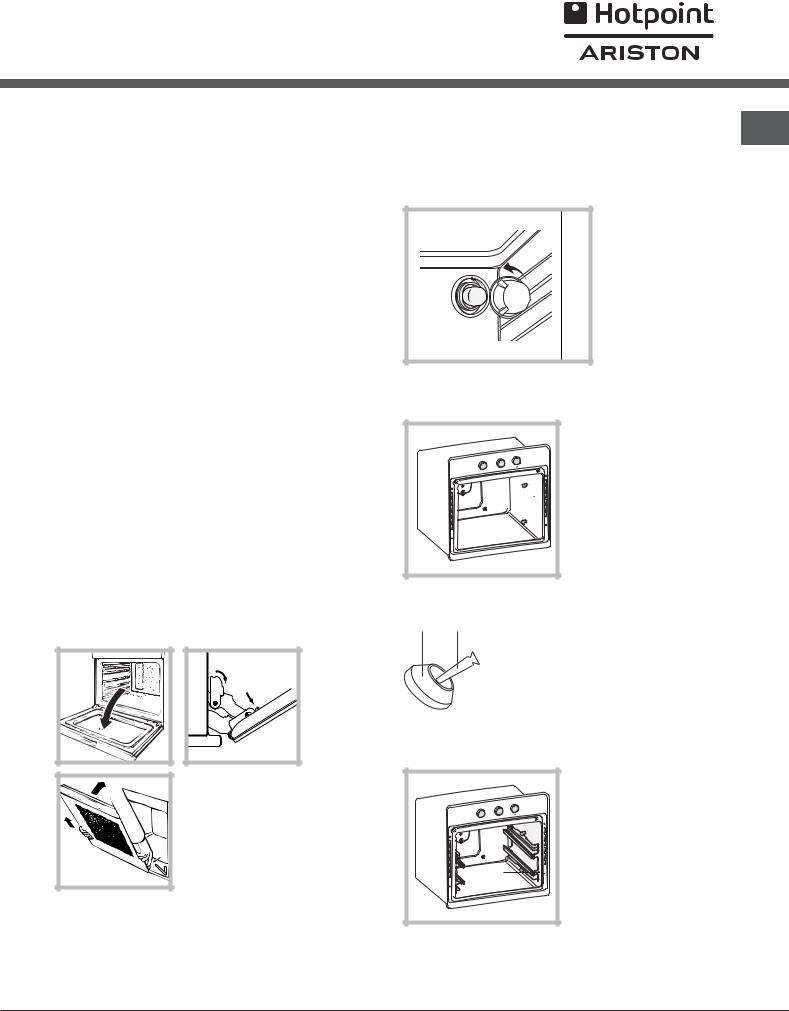
Maintenance and care
Switching the appliance off
Disconnect your appliance from the electricity supply before carrying out any work on it.
Cleaning the appliance
•The stainless-steel or enamel-coated external parts as well as the rubber seals may be cleaned using a sponge that has been soaked in lukewarm water and neutral soap. If these stains are difficult to remove, use only specialised products. After cleaning, rinse and dry thoroughly. Do not use abrasive powders or corrosive substances.
•Ideally, the inside of the oven should be cleaned after each use, when it is still lukewarm. Use hot water and detergent, rinse and dry with a soft cloth. Do not use abrasive products.
•All accessories - with the exception of the sliding racks - can be washed like everyday crockery, and are even dishwasher safe.
Never use steam cleaners or pressure cleaners on the appliance.
Cleaning the oven door
Clean the glass part of the oven door using a sponge and a non-abrasive cleaning product, then dry thoroughly with a soft cloth. Do not use rough abrasive material or sharp metal scrapers as these could scratch the surface and cause the glass to crack. To clean more thoroughly, you can remove the oven door.
1.Open the oven door fully (see diagram).
2.Lift up and turn the small levers located on the two hinges (see diagram).
F |
F |
3. Grip the door on the two external sides and close it approximately half way. Unlock the door by pressing on the clamps F, then pull the door towards you lifting it out of its seat (see diagram).
To replace the door, reverse this sequence.
Inspecting the seals
Check the door seals around the oven periodically. If the seals are damaged, please contact your nearest After-sales Service Centre (see Assistance). We
recommend not using the oven until the seals have |
GB |
been replaced. |
Replacing the light bulb
To replace the oven light bulb:
1.Remove the glass cover of the lamp-holder.
2.Remove the
light bulb and replace it with a similar one: Wattage 25 W, cap E 14.
3. Replace the glass cover (see diagram).
Sliding Rack Kit assembly
To assemble the sliding racks:
|
1. Loosen the two |
|
|
screws A (see diagram). |
|
|
If the oven is fitted with |
|
A |
self-cleaning panels, |
|
these will have to be |
||
|
||
|
temporarily |
|
A |
disassembled. |
2.Replace the screws A with the screws and spacers (B + C) supplied with the kit.
CB
3.Tighten the new screws B and the corresponding spacers C, fitting the self-cleaning panels on again.
D |
4. Secure the two joints D of the guide rail in the holes provided on the oven walls (see diagram). The holes for the left guide rail are situated at the top, while the holes for the right one are at the bottom.
5. Finally, fit the guide rail on the spacer C.
Do not place the sliding racks in position 5.
21

Mode d’emploi
FR
IT |
|
GB |
|
|
FR |
|
|
|
|
|
|
|
|
Italiano, 1 |
English,12 |
Français, 22 |
||||
|
|
|
|
|
|
|
ES |
|
PT |
|
NL |
|
|
|
|
|
|
|
|
|
Espanol, 32 |
Portuges, 42 |
Nederlands, 52 |
||||
DE
Deutsch, 62
F 532 C.1/HA
F 532 C.1 IX/HA
F 53 C.1/HA
F 53 C.1 IX/HA
FOUR
Sommaire
Installation, 23-24
Positionnement
Raccordement électrique
Plaquette signalétique
Description de l’appareil, 25
Vue d’ensemble
Tableau de bord
Mise en marche et utilisation, 26
Mise en marche du four
Programmes, 27-28
Programmes de cuisson
Conseils de cuisson
Tableau de cuisson
Le programmateur de cuisson
électronique, 29
Précautions et conseils, 30
Sécurité générale
Mise au rebut
Economies et respect de l’environnement
Assistance
Nettoyage et entretien, 31
Mise hors tension
Nettoyage de l’appareil
Nettoyage de la porte
Remplacement de l’ampoule d’éclairage
Montage du Kit glissières
